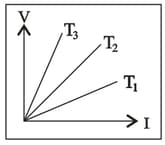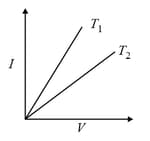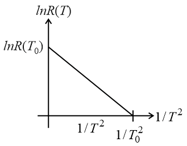Resistance of wire at is . At what temperature, resistance becomes (The temperature coefficient of resistance )
Important Questions on Current Electricity
The figure shows graph between potential difference and current of a metallic wire at three different temperature and . Which of them will have the least value of temperature?

Given below are two statements: one is labelled as Assertion A and the other is labelled as Reason R.
Assertion A: Alloys such as constantan and manganin are used in making standard resistance coils.
Reason R: Constantan and manganin have very small value of temperature coefficient of resistance.
In the light of the above statements, choose the correct answer from the options given below.
and are respectively the current and voltage in a metal wire of resistance The graph for the two different temperatures and are given, then

In an experiment, the resistance of a material is plotted as a function of temperature (in some range). As shown in the figure, it is a straight line.

One may conclude that

